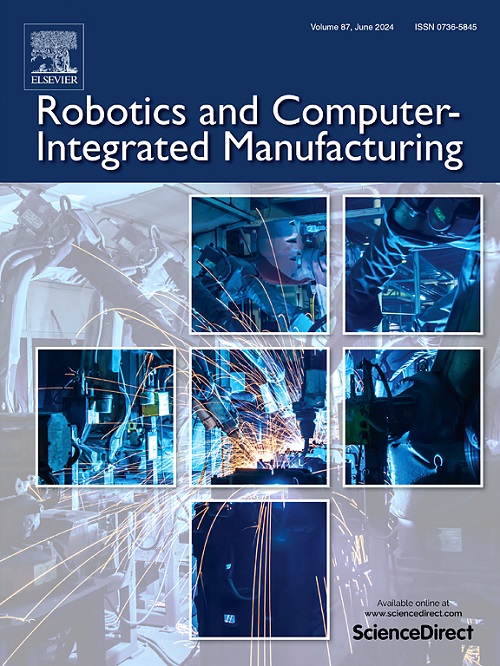高均匀性机器人胶接的物理模拟协同方法
IF 11.4
1区 计算机科学
Q1 COMPUTER SCIENCE, INTERDISCIPLINARY APPLICATIONS
引用次数: 0
摘要
传统的机器人粘接技术存在粘接分布不均匀和覆盖率低的问题,特别是在复杂表面和不同工艺参数下,这阻碍了其在智能制造中的应用。为了克服这些限制,本研究提出了一种物理模拟协同方法,用于预测涂胶线尺寸和优化工具路径规划,旨在提高涂胶质量和生产效率。仿真层采用Whale优化算法结合高斯过程回归建立预测模型,准确捕捉关键工艺参数与胶线尺寸之间的非线性关系。在此基础上,引入代理模型来模拟压缩后的胶线分布。为了确保全覆盖和高均匀性,实现了高均匀性的刀具路径规划策略,利用基于生长的希尔伯特曲线和保角映射在物理环境中复杂表面上生成高效的粘接刀具路径。实验结果验证了该方法在准确预测胶水尺寸、增强覆盖范围和改善粘合性能方面的有效性,证明了该方法适用于涉及复杂表面几何形状的应用。本文章由计算机程序翻译,如有差异,请以英文原文为准。
A Physical-simulation synergy approach for high-uniformity robotic gluing
Traditional robotic gluing techniques suffer from uneven adhesive distribution and low coverage rates, particularly on complex surfaces and under varying process parameters, which impede their application in smart manufacturing. To overcome these limitations, this work presents a physical-simulation synergy approach for predicting glue line dimensions and optimizing toolpath planning, aimed at improving gluing quality and production efficiency. A predictive model is developed in the simulation layer using the Whale Optimization Algorithm combined with Gaussian Process Regression to accurately capture the nonlinear relationships between key process parameters and glue line dimensions. Building on this, a surrogate model is introduced to simulate glue line distribution after compression. To ensure full coverage and high uniformity, a high-uniformity toolpath planning strategy is implemented, utilizing growth-based Hilbert curves and conformal mapping to generate efficient gluing toolpaths on complex surfaces in physical environments. Experimental results validate the effectiveness of the proposed method in accurately predicting glue dimensions, enhancing coverage, and improving adhesive performance, demonstrating its suitability for applications involving complex surface geometries.
求助全文
通过发布文献求助,成功后即可免费获取论文全文。
去求助
来源期刊
CiteScore
24.10
自引率
13.50%
发文量
160
审稿时长
50 days
期刊介绍:
The journal, Robotics and Computer-Integrated Manufacturing, focuses on sharing research applications that contribute to the development of new or enhanced robotics, manufacturing technologies, and innovative manufacturing strategies that are relevant to industry. Papers that combine theory and experimental validation are preferred, while review papers on current robotics and manufacturing issues are also considered. However, papers on traditional machining processes, modeling and simulation, supply chain management, and resource optimization are generally not within the scope of the journal, as there are more appropriate journals for these topics. Similarly, papers that are overly theoretical or mathematical will be directed to other suitable journals. The journal welcomes original papers in areas such as industrial robotics, human-robot collaboration in manufacturing, cloud-based manufacturing, cyber-physical production systems, big data analytics in manufacturing, smart mechatronics, machine learning, adaptive and sustainable manufacturing, and other fields involving unique manufacturing technologies.

 求助内容:
求助内容: 应助结果提醒方式:
应助结果提醒方式:


